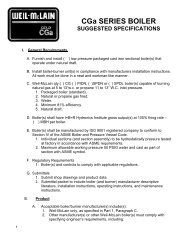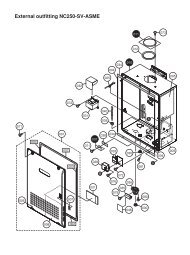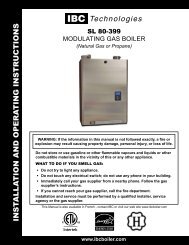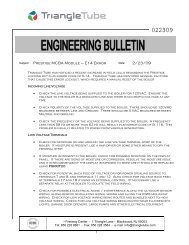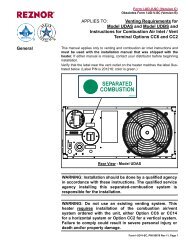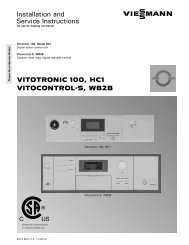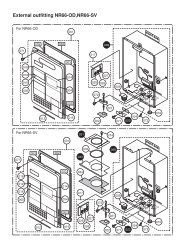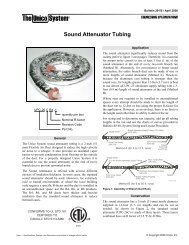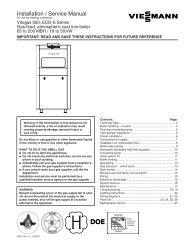Burnham Sage2.1 Boiler Control System - U.S. Boiler Company
Burnham Sage2.1 Boiler Control System - U.S. Boiler Company
Burnham Sage2.1 Boiler Control System - U.S. Boiler Company
Create successful ePaper yourself
Turn your PDF publications into a flip-book with our unique Google optimized e-Paper software.
<strong>Burnham</strong> <strong>Sage2.1</strong> <strong>Boiler</strong> <strong>Control</strong> <strong>System</strong> (SBC2.1) – Overview (con’t)<br />
<strong>Burnham</strong> <strong>Sage2.1</strong> <strong>Boiler</strong> <strong>Control</strong> <strong>System</strong> (SBC2.1) - Overview<br />
The <strong>Burnham</strong> <strong>Sage2.1</strong> is an<br />
“Advanced” <strong>Boiler</strong> <strong>Control</strong> <strong>System</strong><br />
It manages ignition and<br />
modulation of the boiler's<br />
firing rate<br />
It monitors the limit string<br />
It monitors temperatures for<br />
supply/return/stack/outdoor<br />
<br />
It controls pump operation for<br />
boiler, the indirect water<br />
heater, and the system<br />
The <strong>Burnham</strong> <strong>Sage2.1</strong> boiler control system is the next<br />
generation of advanced electronic controls designed<br />
specifically for condensing boilers by U.S. <strong>Boiler</strong><br />
<strong>Company</strong> in partnership with Honeywell. The <strong>Sage2.1</strong> is<br />
currently installed on <strong>Burnham</strong> Alpine condensing boilers<br />
and will be incorporated into additional condensing<br />
boilers in the future.<br />
The <strong>Sage2.1</strong> was designed with many features that<br />
make the control simple to understand and use, as well<br />
as features that optimize boiler performance, flexibility<br />
and overall system efficiency and reliability. The<br />
<strong>Sage2.1</strong> builds on the impressive list of standard<br />
features that were provided with the original Sage2 control system. Additional features<br />
incorporated into the <strong>Sage2.1</strong> system now allow multiple <strong>Sage2.1</strong> equipped boilers to be<br />
connected with simple RJ45 Ethernet cables and staged from an internal sequencer. All the<br />
features on the <strong>Sage2.1</strong> control system make boiler installations more competitive and<br />
easier to install and set up in the field. The <strong>Sage2.1</strong> boiler control system is simply the<br />
most powerful, versatile, and installer-friendly boiler control available and it is only available<br />
on <strong>Burnham</strong> brand products. Here are the key features of this exciting new control system:<br />
• Touch Screen LCD Display: Every boiler equipped with the <strong>Sage2.1</strong> boiler control<br />
will include a built-in LCD touch screen control. <strong>Boiler</strong> status, settings, and diagnostic<br />
information are all accessible from the display in simple English text. <strong>Control</strong> settings can<br />
be adjusted from the display, and advanced settings are protected with two levels of<br />
password protection to prevent advanced settings from being adjusted by unauthorized<br />
users. Built-in diagnostics allow simple trouble-shooting of the boiler. In the event of an<br />
error or lockout, the <strong>Sage2.1</strong> display turns red. Blinking buttons guide the user through<br />
diagnostic screens that explain the issue and how to resolve or repair the issue. Help<br />
screens are provided, offering detailed explanations of each setting in simple terms that are<br />
easy to understand. The <strong>Sage2.1</strong> is intuitive, and guides the user through the settings.<br />
This reduces the amount of time spent on the job scanning through control manuals, and<br />
gets the installer off the job quicker with fewer issues.<br />
• <strong>Control</strong> Data Logging: The <strong>Sage2.1</strong> can display and recall information from<br />
numerous control parameters. The previous five (5) lock-out events can be recalled on the<br />
display. Real time trending tracks the following four parameters: Supply Temperature,<br />
Return Temperature, Flame Signal, and <strong>Boiler</strong> Firing Rate in a running graphic display. The<br />
control also logs runtime hours for the boiler as well as the number of cycles for the boiler,<br />
the boiler pump, the DHW pump, and the system pump. This information can assist in<br />
diagnosing both boiler and system issues, saving valuable time on service calls.<br />
U.S. <strong>Boiler</strong> <strong>Company</strong> – August, 2010 Page 1 of 8
<strong>Burnham</strong> <strong>Sage2.1</strong> <strong>Boiler</strong> <strong>Control</strong> <strong>System</strong> (SBC2.1) – Overview (con’t)<br />
• Outdoor Reset: The <strong>Sage2.1</strong> control features a built-in outdoor reset control which<br />
adjusts boiler temperature based on the outdoor temperature. During warmer<br />
temperatures the building requires less heat, and the boiler temperature is reduced. This<br />
feature helps to keep the boiler in condensing mode longer, resulting in higher efficiency.<br />
In addition, outdoor reset improves comfort by reducing overheating of the zones, and<br />
quiets expansion noises as piping and radiation expands and contracts less. The outdoor<br />
reset curve can be adjusted, using settings that are easy to understand: Outdoor high and<br />
low temperatures, and boiler high and low temperatures.<br />
o With the <strong>Sage2.1</strong>, the Outdoor Reset function is “enabled” as a factory default<br />
setting and does not require the installer to enable the feature on each boiler.<br />
This helps ensure the boiler to operate at the highest possible efficiency.<br />
o The Outside Air Sensor is “enabled” as a factory default setting in <strong>Sage2.1</strong><br />
controls. This saves the installer an additional step when setting up the boiler<br />
and eliminates the possibility of overlooking the setting.<br />
o The “Low <strong>Boiler</strong> Temp” is factory set at 110°F. Adjusting this setting upward<br />
provides higher temperatures across the entire outdoor reset curve and helps to<br />
improve the comfort of the heating system.<br />
o Outdoor Reset Boost feature is factory-set for 20 minutes and will raise the boiler<br />
temperature 10°F if the heat demand is not satisfied within that time frame. The<br />
Boost features allows installer to adjust the boiler with an aggressive outdoor<br />
reset curve in order to maximize system<br />
efficiency and energy savings while ensuring<br />
that the boiler will provide high enough<br />
temperatures to maintain comfort.<br />
• Domestic Priority with Priority<br />
Protection: The <strong>Sage2.1</strong> features built-in<br />
Domestic Priority. When selected, all of the<br />
Alpine’s output is directed to the indirect water<br />
Wall Hung<br />
heater in order to minimize recovery time. Priority<br />
Protection is provided to allow the boiler to<br />
Floor Mount<br />
continue heating the building in the event of<br />
Alpine <strong>Boiler</strong>s with <strong>Sage2.1</strong> <strong>Control</strong> <strong>System</strong><br />
excessive domestic hot water demand. This<br />
feature provides back-up in the event of an excessive demand for hot water, or a<br />
component failure in the hot water system such as a sensor, aquastat, or circulator,<br />
allowing the boiler to continue heating the building and avoid excessive drops in<br />
temperature, or possible freezing.<br />
• Warm Weather Shutdown: Ideal for commercial installations that maintain<br />
heating loop temperatures year round. The Warm Weather Shutdown feature on the<br />
<strong>Sage2.1</strong> control system can be adjusted to allow the heating loop to cool when the<br />
outdoor temperature reaches a specified temperature. This helps to reduce unnecessary<br />
boiler/pump cycling and standby losses. Even with the Warm Weather feature active,<br />
the boiler will still respond to DHW demands.<br />
U.S. <strong>Boiler</strong> <strong>Company</strong> – August, 2010 Page 2 of 8
<strong>Burnham</strong> <strong>Sage2.1</strong> <strong>Boiler</strong> <strong>Control</strong> <strong>System</strong> (SBC2.1) – Overview (con’t)<br />
• Freeze Protection: If possible freezing water temperatures are detected, the<br />
<strong>Sage2.1</strong> will operate all pumps connected to the boiler. If water temperatures continue<br />
to drop, the boiler will operate and heat the system slightly in order to prevent freezing<br />
and damage to the system.<br />
• Pump Exercise: If a circulator that is connected to the <strong>Sage2.1</strong> control does not<br />
operate for seven (7) days, it is activated to run for twenty (20) seconds. This feature<br />
reduces the possibility for pumps to seize and fail due to long periods of inactivity,<br />
improving the overall reliability of the heating system.<br />
• <strong>Control</strong> Flexibility: The <strong>Sage2.1</strong> control can respond to<br />
multiple heating demands, and features adjustable pump<br />
outputs, allowing for greater installation and piping flexibility.<br />
With the touch of a button, pump outputs can be selected for<br />
the boiler, the system, and the domestic hot water pumps. For<br />
example, touch screen selections allow the user to set the<br />
control for either an indirect water heater installed in a boiler<br />
loop or in a system loop. This feature allows full pump control<br />
for an indirect water heater piped off the system loop,<br />
eliminating the costs of additional field-supplied relays, controls,<br />
or wiring. And in some cases, additional savings can be<br />
achieved by reducing the pump size for the indirect water heater.<br />
<strong>Burnham</strong> <strong>Sage2.1</strong><br />
<strong>Control</strong> Module<br />
• Adaptable Firing Rate Output: The <strong>Sage2.1</strong> can be set to respond differently to<br />
various heat demands. This feature allows the boiler’s output to be adjusted for varying<br />
heat loads connected to the system. For example, the boiler can be set to fire at full rate<br />
for a DHW demand; while for a space heating demand, the <strong>Sage2.1</strong> will limit the maximum<br />
firing rate in systems where the domestic hot water demand requires more Btu’s than space<br />
heating. This feature reduces boiler cycling, wear and tear on parts, and enhances heating<br />
efficiency and comfort.<br />
• “Plug & Go” Multiple <strong>Boiler</strong> <strong>Control</strong> Sequencer: When multiple boilers are<br />
installed, the Sequencer that is built into the <strong>Sage2.1</strong> may be used to coordinate and<br />
optimize the operation of up to eight (8) <strong>Sage2.1</strong> equipped boilers. <strong>Boiler</strong>s are connected<br />
.<br />
to a boiler-to-boiler<br />
communication network<br />
by simply "plugging-in"<br />
standard RJ45 cables –<br />
which can be purchased<br />
at most electronics<br />
stores, electric supply<br />
distributors, & office<br />
supply stores, or by<br />
hard wiring between the<br />
control panels of<br />
multiple boilers.<br />
Typical RJ45 Splitter<br />
U.S. <strong>Boiler</strong> <strong>Company</strong> – August, 2010 Page 3 of 8
<strong>Burnham</strong> <strong>Sage2.1</strong> <strong>Boiler</strong> <strong>Control</strong> <strong>System</strong> (SBC2.1) – Overview (con’t)<br />
• The <strong>Sage2.1</strong> Sequencer provides the following:<br />
- <strong>Sage2.1</strong> Sequencer Master: A single <strong>Sage2.1</strong> <strong>Boiler</strong> <strong>Control</strong> is used to control up<br />
to eight (8) <strong>Sage2.1</strong> equipped boilers by enabling its Sequencer Master. The call for heat,<br />
outdoor and header sensors, and pumps are wired to the master enabled <strong>Sage2.1</strong><br />
<strong>Control</strong>ler.<br />
- Multiple Firing Rate Sensor Options: The <strong>Sage2.1</strong> has multiple firing rate<br />
sensor options. Some piping arrangements are better suited to select the firing rate<br />
of the boiler based on the header temperature, rather than the boiler supply<br />
temperature. Multiple boiler systems using the Sage 2.1’s internal sequencer require<br />
the use of a header sensor. This feature enhances the versatility of the Alpine boiler<br />
by integrating into existing systems without requiring additional controls.<br />
- Lead/Slave <strong>Boiler</strong> Sequencing: One boiler is a “Lead” boiler and the<br />
remaining networked boilers are “Slaves”. When demand is increasing, the Lead<br />
boiler is the first to start and the Slave boilers are started in sequential order<br />
(1,2,3,...) until the demand is satisfied. When demand is decreasing, the boilers are<br />
stopped in reverse order which helps equalize run time hours on all boilers.<br />
- Advanced <strong>Boiler</strong> Sequencing: Both header water temperature and boiler<br />
firing rate percentages are used to start and stop the networked boilers. In order to<br />
minimize temperature deviations, the <strong>Sage2.1</strong> control adjusts the number of boilers<br />
running based on the firing rate. This combination allows the boilers to anticipate<br />
slow load changes before they disrupt water temperature yet still respond quickly to<br />
sudden load changes. These special sequencer features help reduce energy-wasting<br />
system temperature swings and the resulting unnecessary boiler cycling. Additionally,<br />
the control monitors boiler<br />
lockout status and<br />
automatically skips over<br />
disabled boilers. The<br />
Sequencer will operate<br />
the boilers as efficiently<br />
a possible by lowering<br />
the firing rates of the<br />
staged boilers in unison<br />
as additional stages are<br />
brought on.<br />
Firing Rates of Staged <strong>Boiler</strong>s<br />
- Improved <strong>System</strong> Reliability: The Sage 2.1 <strong>Control</strong> contains several<br />
features designed to ensure continued boiler operation in the unlikely event of a<br />
sensor or control failure:<br />
1. Backup Header Sensor: In the event of a header sensor failure the lead<br />
boiler’s supply sensor is used by the Sequence Master to control the firing<br />
rate of staged boilers. This feature allows continued Sequencer control in the<br />
event of a header sensor failure.<br />
U.S. <strong>Boiler</strong> <strong>Company</strong> – August, 2010 Page 4 of 8
<strong>Burnham</strong> <strong>Sage2.1</strong> <strong>Boiler</strong> <strong>Control</strong> <strong>System</strong> (SBC2.1) – Overview (con’t)<br />
2. Stand-Alone Back-up: If the Master Sage 2.1 <strong>Control</strong> is powered down,<br />
disabled, or loses communication with connected boilers, individual boilers<br />
can be connected to resume control as stand alone boilers.<br />
3. Slave <strong>Boiler</strong> Rate Adjustment: Each slave boiler continues to monitor supply,<br />
return, and flue gas temperatures and modifies the Sequence Master’s firing<br />
rate demand to help (a.) avoid individual boiler faults, (b.) minimize boiler<br />
cycling, and (c.) operate boiler(s) at peak efficiency.<br />
4. Slave <strong>Boiler</strong> Status Monitoring: The Sequence Master constantly monitors<br />
slave boiler status and will automatically skip over disabled boilers when<br />
staging additional slave boilers.<br />
- Equalized Run Time/Customized Sequences: To equalize the run<br />
time the sequencer automatically rotates the lead boiler after 24 hours of run time.<br />
Normally, boilers are started in boiler numerical order (1,2,3,...) and stopped in<br />
reverse order (...3,2,1). However, custom sequences may be established to<br />
optimize the response. For example, a large boiler may be selected to run first<br />
during winter months and then selected to run last for the remainder of the year.<br />
- Innovative Condensing <strong>Boiler</strong> <strong>Control</strong>: The Sequence Master reduces<br />
firing rates to ensure peak operating efficiency. Lowered firing rates reduce stack<br />
temperatures and maximize the Alpine <strong>Boiler</strong>’s ability to condense flue products<br />
thus saving fuel. In order to maximize fuel efficiency, the <strong>Sage2.1</strong> maintains a<br />
lowered modulation rate until the last boiler is started. At this point, the modulation<br />
rate is released to allow boilers to modulate as required to meet heat load.<br />
- Optimized <strong>Boiler</strong> Modulation: The Sequence Master develops a firing rate<br />
demand based on it's set point and sensed temperature. This demand is used as a<br />
firing rate by each boiler. Each boiler continues to monitor boiler supply<br />
temperatures along with return and flue gas temperatures and then modifies the<br />
modulation rate to minimize boiler cycling and provide heat to the building<br />
efficiently.<br />
- Multiple Demands: The Sequence Master responds to Central Heat, DHW<br />
and frost protection demands similar to the stand-alone boiler. When the Indirect<br />
Water Heater (IWH) parameter is set to "Primary Piped" the Sequence Master<br />
drives the “networked” boilers to the DHW setpoint. When "<strong>Boiler</strong> Piped" is<br />
selected, the individual Slave boiler responds to the DHW demand. The “Primary<br />
Piped” option allows all boilers to be staged for a DHW demand, maximizing<br />
recovery, and providing back-up for DHW with multiple boilers available to respond<br />
to a demand.<br />
- DHW Two-<strong>Boiler</strong> Start: When the Indirect Water Heater (IWH) parameter<br />
is set to "Primary Piped" and the DHW Two <strong>Boiler</strong> Start parameter is enabled two<br />
boilers are started without delay in response to a DHW call for heat. This feature<br />
allows rapid recovery of large DHW demands and multiple Indirect Water Heaters.<br />
U.S. <strong>Boiler</strong> <strong>Company</strong> – August, 2010 Page 5 of 8
<strong>Burnham</strong> <strong>Sage2.1</strong> <strong>Boiler</strong> <strong>Control</strong> <strong>System</strong> (SBC2.1) – Overview (con’t)<br />
• External Multiple <strong>Boiler</strong> <strong>Control</strong> Compatible: The <strong>Sage2.1</strong> control can<br />
be connected to external staging controls and accepts 4-20mA and contact inputs<br />
from a multiple boiler controller. When selected, the <strong>Sage2.1</strong> control system accepts<br />
4-20mA remote setpoint or firing rate demand signals from an external BAS/BMS.<br />
External controls can modulate the Alpine’s firing rate in order to satisfy overall<br />
system demand. No additional relays or wiring is required.<br />
• Energy Management <strong>System</strong> (EMS) Compatible: The <strong>Sage2.1</strong> control can be<br />
connected to a building’s energy management system (EMS) using simple menu selections<br />
and wiring a 4-20m Adc input. The <strong>Sage2.1</strong> allows EMS controls to adjust either the central<br />
heating setpoint or the firing rate of the boiler. This allows the <strong>Sage2.1</strong> to be compatible<br />
with EMS controls that develop energy efficient setpoints based on outside air temperature,<br />
solar loading, and actual room air temperatures. The <strong>Sage2.1</strong> uses this setpoint input to<br />
cycle the boiler and modulate the boiler’s firing rate.<br />
• “Night Setback” and “Unoccupied” <strong>Control</strong> Modes: The <strong>Sage2.1</strong> is<br />
EnviraCom enabled, allowing the boiler to communicate directly with Honeywell<br />
EnviraCom thermostats. This feature allows the boiler to further enhance system<br />
efficiency by reducing the water temperature during home “sleep” and “away” modes.<br />
• Reliability: The <strong>Sage2.1</strong> has been designed to have the best boiler control reliability<br />
and durability available in the industry today. Many of the industry’s most common boiler<br />
control issues have been factored in to the design of the <strong>Sage2.1</strong>. For example, the<br />
<strong>Sage2.1</strong> features built-in brown-out protection. If the power supply temporarily dips in<br />
voltage - a symptom known as a “brown-out”, the <strong>Sage2.1</strong> will re-cycle when voltage<br />
recovers, continuing to heat the building without requiring a service call to manually reset<br />
the control. In addition, no additional devices such as “brown out relays” are required for<br />
the boiler. The <strong>Sage2.1</strong> features duty rated pump relays and wiring, meaning the control<br />
also may not require internal fuse protection for pump outputs if the total amp draw does<br />
not exceed the circuit breaker rating. The control is capable of handling up to 15 amps,<br />
and will not require additional relays to switch power to the circulators in most installations.<br />
<strong>Sage2.1</strong> <strong>Control</strong><br />
<strong>Sage2.1</strong> LCD Touch Screen Display<br />
• Simple and Easy Operation: The<br />
<strong>Sage2.1</strong> boiler control is simple, intuitive, and<br />
easy to operate. The straightforward full text<br />
display shows the settings and status of the<br />
boiler is user-friendly, saving the installer time.<br />
The <strong>Sage2.1</strong> LCD option provides expanded<br />
factory diagnostic screens providing additional<br />
information and troubleshooting assistance.<br />
The <strong>Sage2.1</strong> control does not require special<br />
tools such as handheld electronics, or PC’s with<br />
expensive software and adapters to interface<br />
with the boiler in order to make adjustments or<br />
access operating information.<br />
U.S. <strong>Boiler</strong> <strong>Company</strong> – August, 2010 Page 6 of 8
<strong>Burnham</strong> <strong>Sage2.1</strong> <strong>Boiler</strong> <strong>Control</strong> <strong>System</strong> (SBC2.1) – Overview (con’t)<br />
• Expanded Factory Settings Included with <strong>Sage2.1</strong> <strong>Control</strong> <strong>System</strong>s:<br />
o The Manual Rate Firing Mode includes a timeout feature that will return the boiler to<br />
normal modulation of the firing rate after ten (10) minutes. This ensures the boiler will<br />
modulate properly in the event that the manual firing rate mode is not disabled to the<br />
“off” status after testing.<br />
o <strong>Sage2.1</strong> <strong>Boiler</strong> <strong>Control</strong> <strong>System</strong>s include twenty-nine (29) additional factory diagnostic<br />
screens in LCD Display - gives additional troubleshooting codes and enhanced<br />
information over the original Sage2 control systems.<br />
o Both EnviraCom and conventional thermostats are automatically detected by <strong>Sage2.1</strong><br />
control systems.<br />
o With <strong>Sage2.1</strong> control systems, lockout history is cleared during initial software loading.<br />
<strong>Boiler</strong>s are not sent to the field with “Lockout 22 Safety Data Verification Required”<br />
messages in the “Lockout History” memory.<br />
o High Altitude Capabilities: Alpine High Altitude Models 150, 210, & 285 are certified for<br />
natural gas use up to 10,000 ft.<br />
• Installation & Operation (I&O) Manuals for <strong>Sage2.1</strong> Equipped <strong>Boiler</strong>s<br />
Alpine boiler Installation & Operation (I&O) manuals for <strong>Sage2.1</strong> equipped boilers include<br />
extensive information and clarifications on <strong>Sage2.1</strong> boiler control system capabilities.<br />
In particular, the I&O manual incorporates a simplified piping and pump selection section.<br />
A standardized piping diagram recommends that all indirect water heaters be piped off the<br />
primary loop (shown below and in I&O manual) which is a more reliable method of piping<br />
the indirect water heaters rather than being piped off the boiler loop.<br />
Indirect Water Heaters<br />
Piped off the Primary Loop<br />
U.S. <strong>Boiler</strong> <strong>Company</strong> – August, 2010 Page 7 of 8
<strong>Burnham</strong> <strong>Sage2.1</strong> <strong>Boiler</strong> <strong>Control</strong> <strong>System</strong> (SBC2.1) – Overview (con’t)<br />
• <strong>Sage2.1</strong> Part Numbers:<br />
<strong>Boiler</strong>s equipped with the <strong>Sage2.1</strong><br />
control systems have unique product<br />
coding for easy identification in<br />
computerized inventories. Also,<br />
<strong>Sage2.1</strong> equipped boilers are clearly<br />
marked on the outside of the<br />
packaging. Shown here are <strong>Sage2.1</strong><br />
related part numbers and pricing.<br />
Part<br />
Trade<br />
Description<br />
Number<br />
Price<br />
103192-01 RJ45 Splitter for Ethernet Cables $10<br />
103104-01 10KΩ Header Sensor (well or surface mount) $35<br />
102726-02 LCD Display (Programmed for <strong>Sage2.1</strong>) $250<br />
103141-01 <strong>Sage2.1</strong> <strong>Control</strong> for ALP80-210 & 500 $375<br />
103141-02 <strong>Sage2.1</strong> <strong>Control</strong> for ALP285 $375<br />
103141-03 <strong>Sage2.1</strong> <strong>Control</strong> for ALP399 $375<br />
• Feature Summary of the Sage 2.1 <strong>Control</strong> <strong>Boiler</strong> <strong>Control</strong> <strong>System</strong>:<br />
Unmatched boiler control capabilities available exclusively from U.S. <strong>Boiler</strong> <strong>Company</strong>, Inc. –<br />
manufacturer of <strong>Burnham</strong> ® brand boilers.<br />
<strong>Burnham</strong> <strong>Sage2.1</strong> <strong>Boiler</strong> <strong>Control</strong> <strong>System</strong> Features • Ignition, Temperature, & Limit Monitoring<br />
• Microprocessor <strong>Boiler</strong> <strong>Control</strong> • Built-In Manual Reset High Limit at 210°F<br />
• Auto Reset High Limit<br />
• Active Rate Limit for Flue Temperature<br />
• Manual Reset Flue Temperature Limit<br />
• Adjustable Set Point & DHW Limit Differentials<br />
• Active Firing Rate Limit for Supply & Return Temp. • Flame Current Monitoring<br />
• Blocked Vent Monitoring<br />
• Adjustable Outdoor Reset<br />
• Condensate Trap Float Monitoring<br />
• Warm Weather Shutdown<br />
• <strong>Boiler</strong> and <strong>System</strong> Frost Protection<br />
• Unoccupied Mode (When Connected to EnviraCom T-Stat)<br />
• Night Setback (When Connected to EnviraCom T-Stat) • Adjustable DHW Priority<br />
• Adjustable Outdoor Reset Boost<br />
• Adjustable Maximum Firing Rates for DHW<br />
• DHW Priority Protection and Space Heating Demands<br />
• 3-Pump Outputs (<strong>Boiler</strong>, <strong>System</strong>, DHW)<br />
• Adjustable Pump Operation<br />
• Pump Exercise<br />
• <strong>Boiler</strong> Anti-Cycling<br />
• 4-20mA BMS Staging Input<br />
• Remote <strong>Control</strong> of Firing Rate<br />
• Remote <strong>Control</strong> of Temperature Set Point<br />
• ModBus Operation (single boiler)<br />
• EnviraCom Enabled<br />
• Alarm Contacts for <strong>Boiler</strong> Lock-Out<br />
• Built-In Sequencer for up to 8 <strong>Boiler</strong>s<br />
• RJ45 Jacks for <strong>Boiler</strong> to <strong>Boiler</strong> Connection<br />
• Adjustable Lead Lag Rotation<br />
• Adjustable PID for Staging<br />
• Optimized Efficiency Staging<br />
• Slave <strong>Boiler</strong> Monitoring<br />
• Multi-<strong>Boiler</strong> DHW Staging<br />
• Two <strong>Boiler</strong> DHW Start<br />
• Data Logging for <strong>Boiler</strong> Lock-Outs<br />
• <strong>Boiler</strong> Run Time & Cycle History<br />
• Pump Cycle History<br />
• 2 - Level Password Protection<br />
• Multi-Color LCD Touch Screen Display<br />
• Full Text Display of Settings<br />
• Active Buttons for Clear Navigation<br />
• Graphic Display of Sensor Values<br />
• Graphic Display of Limit Status<br />
• Graphic Display of Outdoor Reset Curve<br />
• Real-Time Trend Display of:<br />
• Over 120 Help Screens with Full Text<br />
- Supply Temperature - Flame Signal Explanations of Terms, Settings, Status,<br />
- Return Temperature - Firing Rate and Troubleshooting Information<br />
• Self-Guided Diagnostics<br />
• Programmable Service Contact Information<br />
• Energy Save Display<br />
• Maximum Efficiency Display<br />
• Separate Low & Line Voltage Terminal Strips<br />
• Multiple Firing Rate Sensor Options<br />
U.S. <strong>Boiler</strong> <strong>Company</strong> – August, 2010 Page 8 of 8




